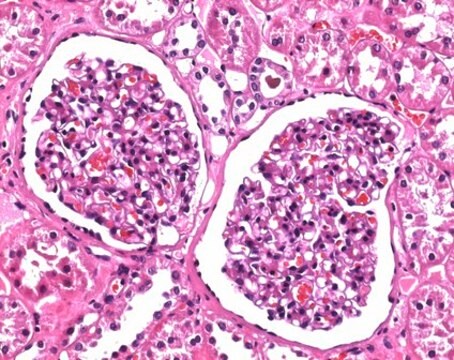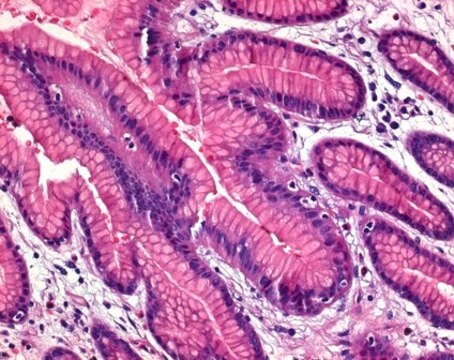Wichtige Dokumente
47608
Formaldehyd -Lösung
for molecular biology, BioReagent, ≥36.0% in H2O (T)
Synonym(e):
Formalin
About This Item
Empfohlene Produkte
Qualität
for molecular biology
Qualitätsniveau
Dampfdichte
1.03 (vs air)
Dampfdruck
52 mmHg ( 37 °C)
Produktlinie
BioReagent
Form
liquid
Selbstzündungstemp.
572 °F
Enthält
~10% methanol as stabilizer
Konzentration
≥36.0% in H2O (T)
36.0-38.0% (aldehyde method)
Methode(n)
electrophoresis: suitable
Verunreinigungen
≤0.03% free acid (as HCOOH)
Glührückstand
≤0.05% (as SO4)
pH-Wert
2.8-4.0
Dichte
1.09 g/mL at 20 °C
1.09 g/mL at 25 °C (lit.)
Anionenspuren
chloride (Cl-): ≤10 mg/kg
sulfate (SO42-): ≤20 mg/kg
Kationenspuren
Ca: ≤5 mg/kg
Cd: ≤1 mg/kg
Co: ≤1 mg/kg
Cr: ≤1 mg/kg
Cu: ≤1 mg/kg
Fe: ≤1 mg/kg
K: ≤20 mg/kg
Mg: ≤1 mg/kg
Mn: ≤1 mg/kg
Na: ≤100 mg/kg
Ni: ≤1 mg/kg
Pb: ≤1 mg/kg
Zn: ≤1 mg/mL
λ
2 M in H2O
UV-Absorption
λ: 260 nm Amax: 0.01
λ: 280 nm Amax: 0.01
Eignung
in accordance for electrophoresis of RNA in agarose gels
Lagertemp.
room temp
SMILES String
[H]C([H])=O
InChI
1S/CH2O/c1-2/h1H2
InChIKey
WSFSSNUMVMOOMR-UHFFFAOYSA-N
Suchen Sie nach ähnlichen Produkten? Aufrufen Leitfaden zum Produktvergleich
Allgemeine Beschreibung
It is an aliphatic aldehyde that is widely used in industrial applications for the synthesis of several chemicals such as melamine formaldehyde, urea-formaldehyde, phenol formaldehyde and industrial resins, paraformaldehyde, polyols, chelating agents, slow release fertilizers, 1,4-butanediol and hexamethylenetetramine.
Anwendung
- denaturation and separation of RNA molecules
- anti-bacterial treatment
- fixation of cells
- in the fixation of human spermatogonial stem cell transplantation (SSCT).
- to crosslink T- cell acute lymphoblastic leukemia protein/DNA complex during chromatin immunoprecipitation.
- in fixing zebra fish larvae for neutrophil staining.
Vorsicht
Prinzip
Signalwort
Danger
Gefahreneinstufungen
Acute Tox. 2 Inhalation - Acute Tox. 3 Dermal - Acute Tox. 3 Oral - Carc. 1B - Eye Dam. 1 - Flam. Liq. 3 - Muta. 2 - Skin Corr. 1B - Skin Sens. 1 - STOT SE 1 - STOT SE 3
Zielorgane
Eyes,Central nervous system, Respiratory system
Lagerklassenschlüssel
3 - Flammable liquids
WGK
WGK 3
Flammpunkt (°F)
133.0 °F - closed cup
Flammpunkt (°C)
56.11 °C - closed cup
Persönliche Schutzausrüstung
Faceshields, Gloves, Goggles, type ABEK (EN14387) respirator filter
Analysenzertifikate (COA)
Suchen Sie nach Analysenzertifikate (COA), indem Sie die Lot-/Chargennummer des Produkts eingeben. Lot- und Chargennummern sind auf dem Produktetikett hinter den Wörtern ‘Lot’ oder ‘Batch’ (Lot oder Charge) zu finden.
Besitzen Sie dieses Produkt bereits?
In der Dokumentenbibliothek finden Sie die Dokumentation zu den Produkten, die Sie kürzlich erworben haben.
Kunden haben sich ebenfalls angesehen
Artikel
rganoid culture products to generate tissue and stem cell derived 3D brain, intestinal, gut, lung and cancer tumor organoid models.
Unser Team von Wissenschaftlern verfügt über Erfahrung in allen Forschungsbereichen einschließlich Life Science, Materialwissenschaften, chemischer Synthese, Chromatographie, Analytik und vielen mehr..
Setzen Sie sich mit dem technischen Dienst in Verbindung.










